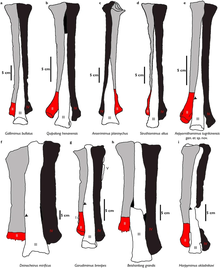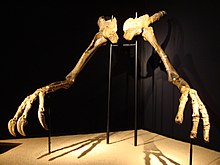Garudimimus
| Garudimimus | |
|---|---|

| |
| Mounted holotype in the Mongolian Natural History Museum during 2002 (note incorrect number of caudal vertebrae; only four are reported in the holotype) | |
| Scientific classification | |
| Domain: | Eukaryota |
| Kingdom: | Animalia |
| Phylum: | Chordata |
| Clade: | Dinosauria |
| Clade: | Saurischia |
| Clade: | Theropoda |
| Clade: | †Ornithomimosauria |
| Clade: | † Macrocheiriformes
|
| Superfamily: | † Ornithomimoidea
|
| Genus: | †Garudimimus Barsbold, 1981 |
| Type species | |
| †Garudimimus brevipes Barsbold, 1981
| |
Garudimimus (meaning "
The only known specimen of Garudimimus was a medium-sized animal measuring nearly 3.5 m (11.5 ft) in length and weighing about 77.3–98 kg (170–216 lb). It was an ornithomimosaur with a mix of basal and derived features; unlike primitive ornithomimosaurs, both upper and lower jaws were
With the first description in 1981, Garudimimus was identified as a primitive ornithomimosaurian within its own family. However, with the description of new specimens of
History of discovery

In 1981, during a Soviet-Mongolian paleontological expedition to the
The holotype consist of the
In 1988 the

In 1994, Bernardino P. Pérez-Moreno with colleagues described the primitive ornithomimosaur
Although Garudimimus is solely known from MPC-D 100/13, additional specimens may potentially be present among a large
Description

Garudimimus (based on the holotype specimen) is estimated to have been around 3.5 m (11.5 ft) weighing approximately 77.3–98 kg (170–216 lb).[14][15][16] Several unfused vertebrae indicates that the holotype was likely a still-growing sub-adult animal.[4] Some of the distinguishing traits of this taxon include the jaw articulation positioned more backwards than the postorbital bar (arched bone around the orbit, also referred as the postorbital), depressions on the upper surface of the supraoccipital at the back of the skull, paired depressions on the lateral surfaces of the neural spines of the anterior caudal vertebrae, and a deep groove at the upper end of lateral surface of pedal phalanges III-1 and III-2 (first and second phalanxes of the third digit of the foot).[4]
Based on feather impressions of several specimens of
Skull

Garudimimus had a rather small

The lacrimal bone was semi T-shaped and located in front of the eye. The prefrontal bone was a thin and delicate bone that contributed to the overall shape of the eye socket. In a top view, the frontals were triangular and formed the upper borders of the eye socket. Both frontals together formed a single dome-like structure. The posterior border of the eye socket was formed by the postorbital, which was a sharply-developed bone of well-distributed thickness in lateral view. The jugal had a triangular main body with very thin-walled processes (bony extensions); it also gave form to the lower border of the eye socket. The quadratojugal was a large and triangular-shaped bone, contrasting with the L-shaped quadratojugal of most ornithomimosaurs.[4] On its posterior surface, the quadrate had a large, oval-shaped depression positioned at its mid-height. A small pneumatic foramen (hole) was also present in the bottom area of the depression.[20] The dentary was the longest mandibular element measuring 18.3 cm (183 mm) long and was thickened towards the end. The front of both dentaries was shovel-like and had well-developed cutting edges. Numerous foramina were developed on the lateral surfaces of the dentary tip. The surangular was the second large mandibular element and formed the upper border of the mandibular fenestra (a hole in the lower jaw). Compared to the two latter bones, the angular was much smaller and formed the lower border of this fenestra.[4]
Postcranial skeleton

The complete vertebral column of Garudimimus is not known. The intercentrum and neural arch of the atlas were downwards-directed. The central length of the axis was rather short, measuring approximately 3 cm (30 mm) long and 1.8 cm (18 mm) high—probably a primitive condition in ornithomimosaurs. Its posterior articular surface was concave and taller than wide. Its neural spine was tall and very rounded, and its neural arch had a pneumatic fossa (depression) at the mid-length of its centrum (body). The neural spines of most cervical vertebrae were narrow and directed towards the end. The dorsal vertebrae progressively increased in size towards the end and along with the size, the neural spines became progressively taller in posterior dorsals with nearly equal lengths. In a lateral view, all spines were slightly inclined towards the end. The dorsal centra lacked pneumatization and were larger in more posterior vertebrae, having amphicoelous (strongly concave) facets.[4]

The

The ribs had a short tuberculum (upper head) and long capitulum (lower head), and the gastralia (belly ribs) were segmented into lateral and inner parts. Most sacral ribs were poorly developed. The pelvic girdle was formed by the ilium, pubis, and ischium. Though the latter is unknown in Garudimimus. The ilium was a large bone—yet short compared to ornithomimids—with a hook-shaped anterior end. The pubis was a large element measuring 39 cm (390 mm) in length. It had a nearly straight shaft and a prominent pubic boot (large projection at the end). The femur was relatively straight and had a length of 37.1 cm (371 mm). It had a well-developed femoral head and a sideways flattened shaft. Both tibia and fibula were nearly equal in length to the femur (36 cm (360 mm) and 38.8 cm (388 mm) respectively). The tibia was more flattened than other limb elements and the shaft was very thin. The astragalus and calcaneum were attached to the lower sides of the tibia.[4]
In the
Classification

In 1981, Barsbold assigned Garudimimus to a separate
More recently, in 2019 Hartman and colleagues described the new paravian Hesperornithoides performing an extensive phylogenetic analysis for the Coelurosauria. In the case of ornithomimosaurs, the Garudimimidae was recovered as a family containing Garudimimus and close relatives. Garudimimus was recovered in a rather derived position as the sister taxon of Beishanlong. This analysis found close relationship between Deinocheirus and Garudimimus to be unlikely, with the former recovered at the near base of Ornithomimosauria.[23]
Left cladogram per Lee and colleagues in 2014,[22] right cladogram per Hartman and colleagues in 2019:[23]
|
|
In 2020, Serrano-Brañas and team described and named the new deinocheirid genus Paraxenisaurus from the Cerro del Pueblo Formation. This is the first member of the group to be found outside Asia and its discovery could indicate that deinocheirids originated in Laurasia (northern supercontinent during the Mesozoic) or that they dispersed across polar regions in the Northern Hemisphere; a similar interchange is also known to have occurred in other dinosaur groups with Asian affinities during the Campanian-Maastrichtian ages. The team found Harpymimus to be a rather primitive deinocheirid, however, Beishanlong was placed outside the group. Garudimimus and Deinocheirus were recovered again as closely related taxa with the addition of Paraxenisaurus in a polytomy.[24]
Paleobiology
Daily activity
Limb proportions, pedal unguals morphology and the extension of the ilium of Garudimimus suggest that it was not adapted for speed as in the more
However, this analysis was criticized in the same year by Hall and colleagues arguing against the methods employed by Schmitz and Motani in that there is a considerable degree of similarities on scleral anatomy between diurnal, cathemeral and nocturnal animals. Moreover,
Senses
In 2019, Graham M. Hughes and John A. Finarelli analyzed the
Feeding habits
Kobayashi and Barsbold stated in 2005 that the absence of dentition on the lower jaw and the recurved shape of the same indicates that Garudimimus was fairly more similar to ornithomimids when consuming food than to other primitive ornithomimosaurs. Like ornithomimids, the anterior parts of the upper and lower jaws of Garudimimus were both covered by a beak and may have been used for plucking food. In addition, the sharp edges on the middle portions of the jaws helped for cutting food.[4] Moreover, Garudimimus and kin are widely regarded as herbivore or at least omnivore dinosaurs by their peculiar anatomical traits—including the presence of a beak.[29][25]
In 2015, Andrew R. Cuff and Emily J. Rayfield performed

In 2019,
During the same year, Ali Nabavizadeh studied the
Paleoenvironment
The known remains of Garudimimus were unearthed from the Late Cretaceous
Numerous scale-like cross-stratifications at the Baynshire locality are indicators of large meanders, and the vast majority of these water bodies may have drained the eastern part of the
Garudimimus shared its habitat with multiple dinosaurian
See also
References
- ^ S2CID 195060070. Translated paper
- ^ Barsbold, R. (1983). "Хищные динозавры мела Монголии" [Carnivorous dinosaurs from the Cretaceous of Mongolia] (PDF). Transactions of the Joint Soviet-Mongolian Paleontological Expedition (in Russian). 19: 1−120. Translated paper
- ISBN 9780520067271.
- ^ hdl:2115/14579.
- ISBN 978-0-671-61946-6.
- doi:10.1139/e88-097.
- ^ Holtz, T. R. (1992). An unusual structure of the metatarsus of Theropoda (Archosauria: Dinosauria: Saurischia) of the Cretaceous (PhD thesis). Yale University. p. 347.
- ^ .
- JSTOR 4523590.
- S2CID 4302245.
- ^ a b Chinzorig, T.; Kobayashi, Y.; Saneyoshi, M.; Tsogtbaatar, K.; Batamkhatan, Z.; Ryuji, T. (2017). "Multitaxic bonebed of two new ornithomimids (Theropoda, Ornithomimosauria) from the Upper Cretaceous Bayanshiree Formnation of southeastern Gobi desert, Mongolia". Journal of Vertebrate Paleontology. Program and Abstracts: 97.
- .
- hdl:2115/74432.
- OCLC 38325967.
- PMID 23193135.
- PMC 9581415.
- S2CID 2057698.
- .
- ^ PMID 26213655.
- PMID 26401455.
- PMID 26682888.
- ^ S2CID 2986017.
- ^ PMID 31333906.
- S2CID 218968100.
- ^ S2CID 33253407.
- PMID 22194558.
- PMID 22194558.
- PMID 31185870.
- .
- S2CID 208652510.
- S2CID 207815224.
- ^ .
- ^ .
- ^ a b Ishigaki, S.; Tsogtbaatar, K.; Saneyoshi, M.; Mainbayar, B.; Aoki, K.; Ulziitseren, S.; Imayama, T.; Takahashi, A.; Toyoda, S.; Bayardorj, C.; Buyantegsh, B.; Batsukh, J.; Purevsuren, B.; Asai, H.; Tsutanaga, S.; Fujii, K. (2016). "Report of the Okayama University of Science - Mongolian Institute of Paleontology and Geology Joint Expedition in 2016" (PDF). Bulletin of Research Institute of Natural Sciences (42): 33−46.
- .
- S2CID 86304259.
- ^ S2CID 197584839.
- S2CID 54210424. Archived from the original(PDF) on 2019-03-07.
- doi:10.1016/j.jseaes.2017.12.007. Archived from the original(PDF) on 2020-09-19. Retrieved 2020-09-02.
- PMID 30995236.
- ^ S2CID 212423361.
- S2CID 216499705.
- ^ PMID 27069815.
- ISBN 9780691167664.
- S2CID 213247742.
- ^ Watabe, M.; Suzuki, S. (2000). "Report on the Japan - Mongolia Joint Paleontological Expedition to the Gobi desert, 1993". Hayashibara Museum of Natural Sciences Research Bulletin. 1: 19−29.
- ^ Watabe, M.; Suzuki, S. (2000). "Report on the Japan - Mongolia Joint Paleontological Expedition to the Gobi desert, 1994". Hayashibara Museum of Natural Sciences Research Bulletin. 1: 30−44.
External links
 Media related to Garudimimus at Wikimedia Commons
Media related to Garudimimus at Wikimedia Commons Data related to Garudimimus at Wikispecies
Data related to Garudimimus at Wikispecies- 3D holotype skull at Phenome10k
- 3D reconstructed holotype skull at Phenome10k
- Mounted holotype cast at YouTube
